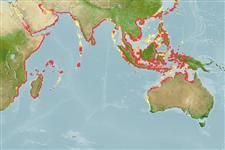Teleostei (teleosts) >
Eupercaria/misc (Various families in series Eupercaria) >
Nemipteridae (Threadfin breams, Whiptail breams)
Etymology: Scolopsis: Name from the Greek masculine noun 'skolos' meaning 'thorn' and suffix '-opsis' (from Greek feminine n. 'opsis' meaning 'aspect', 'appearance') meaning ‘thorny appearance’ presumably referring to 'les dentelures de la préopercule, en ont aussi, et même d'épineuses, aux sous-orbitaires' mentioned by Cuvier (1814) in his designation of the genus. Name ending in -'opsis' are treated as feminine according to ICZN 1999: Article 30.1.2 (Ref. 130620); vosmeri: Name from the acronym of the Indira Gandhi Centre for Atomic Research (IGCAR), Kalpakkam, where it was first collected..
More on author: Bloch.
Environment: milieu / climate zone / depth range / distribution range
Ecology
Marine; reef-associated; depth range 2 - 25 m (Ref. 9710). Tropical
Indo-West Pacific: northern Indian Ocean (except the Red Sea, Arabian Gulf, east African coast, islands), from Pakistan, western India, Sri Lanka; Bay of Bengal and Andaman to western Indonesia and Borneo (East Malaysia and Brunei).
Size / Weight / Age
Maturity: Lm ? range ? - ? cm
Max length : 17.3 cm SL male/unsexed; (Ref. 130620); common length : 15.0 cm SL male/unsexed; (Ref. 3810)
Dorsal spines (total): 10; Dorsal soft rays (total): 9; Anal spines: 3; Anal soft rays: 7; Vertebrae: 22. This species is distinguished by the following set of characters: scaly temporal region with scales on top of head reaching forward to just in front of the anterior nostrils; naked suborbital; the lower margin of the eye is tangent to or just above a line from snout tip to upper pectoral-fin base; exposed bony ridge below the eye with an antrorse and retrorse spine; scales on preopercle are extending to posterior margin, scales behind suborbital 5-6 rows and behind eye 3-4 rows; the lower limb of preopercle usually has a single row of embedded scales; scales on opercle 4-7 rows; most body scales (except for caudal peduncle) have a black spot; caudal peduncle white; usually a white band is present beneath lateral line, from origin of lateral line to below posterior part of dorsal fin; from nape onto operculum is a broad white bar, and suborbital with distinctive white patch - all these not present in juveniles and smaller subadults; upper limb of opercular margin narrowly brown, the lower limb narrowly reddish-orange; upper base of pectoral fin with a small dark spot; pelvic and anal fins are crimson or orange-red (Ref. 120656).
Benthic in inshore turbid or weedy waters, usually on sand or mud or rubble bottoms close to reefs, in depths to about 30 m (Ref. 92980), as well as offshore areas (Ref. 9785). Seen solitary, but may school deep (Ref. 48635).
Life cycle and mating behavior
Maturities | Reproduction | Spawnings | Egg(s) | Fecundities | Larvae
Russell, B.C., S.V. Bogorodsky, A.O. Mal, K.K. Bineesh and T.J. Alpermann, 2022. The taxonomic identity of the monocle bream Scolopsis vosmeri species complex (Perciformes: Nemipteridae), with comments on molecular phylogenetic relationships within the genus Scolopsis. Zootaxa 5105(4):501-538. (Ref. 130620)
IUCN Red List Status (Ref. 130435)
Threat to humans
Harmless
Human uses
Fisheries: commercial; gamefish: yes
Tools
Special reports
Download XML
Internet sources
Estimates based on models
Preferred temperature (Ref.
123201): 25.4 - 29.3, mean 28.6 °C (based on 2454 cells).
Phylogenetic diversity index (Ref.
82804): PD
50 = 0.5000 [Uniqueness, from 0.5 = low to 2.0 = high].
Bayesian length-weight: a=0.01514 (0.00834 - 0.02746), b=3.03 (2.88 - 3.18), in cm total length, based on LWR estimates for this species & Genus-body shape (Ref.
93245).
Trophic level (Ref.
69278): 4.6 ±0.09 se; based on food items.
Resilience (Ref.
120179): High, minimum population doubling time less than 15 months (Preliminary K or Fecundity.).
Fishing Vulnerability (Ref.
59153): Low vulnerability (11 of 100).
Nutrients (Ref.
124155): Calcium = 64 [40, 132] mg/100g; Iron = 0.686 [0.339, 1.648] mg/100g; Protein = 19 [17, 21] %; Omega3 = 0.144 [0.087, 0.239] g/100g; Selenium = 26.1 [15.3, 47.0] μg/100g; VitaminA = 78.8 [22.0, 230.3] μg/100g; Zinc = 1.35 [0.93, 1.95] mg/100g (wet weight);
